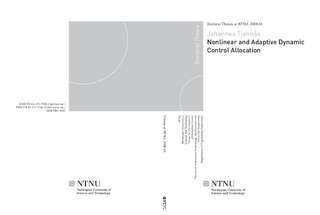| dc.contributor.author | Tjønnås, Johannes | nb_NO |
| dc.date.accessioned | 2014-12-19T14:00:59Z | |
| dc.date.available | 2014-12-19T14:00:59Z | |
| dc.date.created | 2008-06-30 | nb_NO |
| dc.date.issued | 2008 | nb_NO |
| dc.identifier | 124748 | nb_NO |
| dc.identifier.isbn | 978-82-471-7250-6 | nb_NO |
| dc.identifier.uri | http://hdl.handle.net/11250/259444 | |
| dc.description.abstract | This work addresses the control allocation problem for a nonlinear over-actuated time-varying system where parameters a¢ ne in the actuator dynamics and actuator force model may be assumed unknown. Instead of optimizing the control allocation at each time instant, a dynamic approach is considered by constructing update-laws that represent asymptotically optimal allocation search and adaptation. A previous result on uniform global asymptotic stability (UGAS) of the equilibrium of cascaded time-varying systems, is in the thesis shown to also hold for closed (not necessarily compact) sets composed by set-stable subsystems of a cascade. In view of this result, the optimal control allocation approach is studied by using Lyapunov analysis for cascaded set-stable systems, and uniform global/local asymptotic stability is guaranteed for the sets described by; the system dynamics, the optimizing allocation update-law and the adaptive update-law.
The performance of the proposed control allocation scheme is demon- strated throughout the thesis by simulations of a scaled-model ship manoeuvred at low-speed. Furthermore, the application of a yaw stabilization scheme for an automotive vehicle is presented. The stabilization strategy consists of; a high level module that deals with the vehicle motion control objective (yaw rate reference generation and tracking), a low level module that handles the braking control for each wheel (longitudinal slip control and maximal tyre road friction parameter estimation) and an intermediate level dynamic control allocation module. The control allocation module generates longitudinal slip reference for the low level brake controller and commands front wheel steering angle corrections, such that the actual torque about the yaw axis tends to the desired torque calculated by the high level module. The conditions for uniform asymptotic stability are given and the scheme has been implemented in a realistic nonlinear multi-body vehicle simulation environment. The simulation cases show that the control strategy stabilizes the vehicle in extreme manoeuvres where the nonlinear vehicle yaw dynamics otherwise become unstable in the sense of over- or understeering. | nb_NO |
| dc.language | eng | nb_NO |
| dc.publisher | Fakultet for informasjonsteknologi, matematikk og elektroteknikk | nb_NO |
| dc.title | Nonlinear and Adaptive Dynamic Control Allocation | nb_NO |
| dc.type | Doctoral thesis | nb_NO |
| dc.contributor.department | Norges teknisk-naturvitenskapelige universitet, Fakultet for informasjonsteknologi, matematikk og elektroteknikk, Institutt for teknisk kybernetikk | nb_NO |
| dc.description.degree | PhD i informasjons- og kommunikasjonsteknologi | nb_NO |
| dc.description.degree | PhD in Information and Communications Technology | en_GB |
